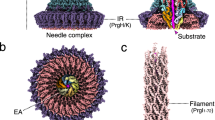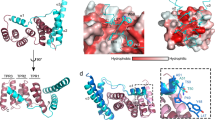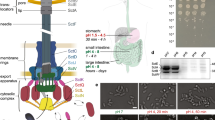Abstract
Type III protein secretion systems are essential virulence factors of many bacteria pathogenic to humans, animals and plants1. These systems mediate the transfer of bacterial virulence proteins directly into the host cell cytoplasm. Proteins are thought to travel this pathway in a largely unfolded manner, and a family of customized cytoplasmic chaperones, which specifically bind cognate secreted proteins, are essential for secretion. Here we show that InvC, an ATPase associated with a Salmonella enterica type III secretion system2, has a critical function in substrate recognition. Furthermore, InvC induces chaperone release from and unfolding of the cognate secreted protein in an ATP-dependent manner. Our results show a similarity between the mechanisms of substrate recognition by type III protein secretion systems and AAA + ATPase disassembly machines.
This is a preview of subscription content, access via your institution
Access options
Subscribe to this journal
Receive 51 print issues and online access
$199.00 per year
only $3.90 per issue
Buy this article
- Purchase on Springer Link
- Instant access to full article PDF
Prices may be subject to local taxes which are calculated during checkout




Similar content being viewed by others
References
Galán, J. E. & Collmer, A. Type III secretion machines: bacterial devices for protein delivery into host cells. Science 284, 1322–1328 (1999)
Eichelberg, K., Ginocchio, C. & Galán, J. E. Molecular and functional characterization of the Salmonella typhimurium invasion genes invB and invC: Homology of InvC to the FOF1 ATPase family of proteins. J. Bacteriol. 176, 4501–4510 (1994)
Cornelis, G. R. & Van Gijsegem, F. Assembly and function of type III secretory systems. Annu. Rev. Microbiol. 54, 735–774 (2000)
Kubori, T. et al. Supramolecular structure of the Salmonella typhimurium type III protein secretion system. Science 280, 602–605 (1998)
Marlovits, T. C. et al. Structural insights into the assembly of the type III secretion needle complex. Science 306, 1040–1042 (2004)
Stebbins, C. E. & Galan, J. E. Priming virulence factors for delivery into the host. Nature Rev. Mol. Biol. 4, 738–743 (2003)
Stebbins, C. E. & Galán, J. E. Maintenance of an unfolded polypeptide by a cognate chaperone in bacterial type III secretion. Nature 414, 77–81 (2001)
Birtalan, S. C., Phillips, R. M. & Ghosh, P. Three-dimensional secretion signals in chaperone-effector complexes of bacterial pathogens. Mol. Cell 9, 971–980 (2002)
Michiels, T. & Cornelis, G. R. Secretion of hybrid proteins by the Yersinia Yop export system. J. Bacteriol. 173, 1677–1685 (1991)
Ramamurthi, K. S. & Schneewind, O. Substrate recognition by the Yersinia type III protein secretion machinery. Mol. Microbiol. 50, 1095–1102 (2003)
Lloyd, S. A., Forsberg, A., Wolf-Watz, H. & Francis, M. S. Targeting exported substrates to the Yersinia TTSS: different functions for different signals? Trends Microbiol. 9, 367–371 (2001)
Galán, J. E. Salmonella interaction with host cells: Type III secretion at work. Annu. Rev. Cell Dev. Biol. 17, 53–86 (2001)
Dreyfus, G., Williams, A. W., Kawagishi, I. & Macnab, R. M. Genetic and biochemical analysis of Salmonella typhimurium FliI, a flagellar protein related to the catalytic subunit of the FOF1 ATPase and to virulence proteins of mammalian and plant pathogens. J. Bacteriol. 175, 3131–3138 (1993)
Pozidis, C. et al. Type III protein translocase: HrcN is a peripheral ATPase that is activated by oligomerization. J. Biol. Chem. 278, 25816–25824 (2003)
Claret, L., Calder, S. R., Higgins, M. & Hughes, C. Oligomerization and activation of the FliI ATPase central to bacterial flagellum assembly. Mol. Microbiol. 48, 1349–1355 (2003)
Akeda, Y. & Galan, J. E. Genetic analysis of the Salmonella enterica type III secretion-associated ATPase InvC defines discrete functional domains. J. Bacteriol. 186, 2402–2412 (2004)
Kaniga, K., Uralil, J., Bliska, J. B. & Galán, J. E. A secreted tyrosine phosphatase with modular effector domains encoded by the bacterial pathogen Salmonella typhimurium. Mol. Microbiol. 21, 633–641 (1996)
Stebbins, C. E. & Galán, J. E. Modulation of host signalling by a bacterial mimic: structure of the Salmonella effector SptP bound to Rac1. Mol. Cell 6, 1449–1460 (2000)
Gauthier, A. & Finlay, B. B. Translocated intimin receptor and its chaperone interact with ATPase of the type III secretion apparatus of enteropathogenic Escherichia coli. J. Bacteriol. 185, 6747–6755 (2003)
Luo, Y. et al. Structural and biochemical characterization of the type III secretion chaperones CesT and SigE. Nature Struct. Biol. 8, 1031–1036 (2001)
Farr, G., Scharl, E., Schumacher, R., Sondek, S. & Horwich, A. Chaperonin-mediated folding in the eukaryotic cytosol proceeds through rounds of release of native and nonnative forms. Cell 89, 927–937 (1997)
Lee, S. H. & Galan, J. E. Salmonella type III secretion-associated chaperones confer secretion-pathway specificity. Mol. Microbiol. 51, 483–495 (2004)
Lee, V. T. & Schneewind, O. Yop fusions to tightly folded protein domains and their effects on Yersinia enterocolitica type III secretion. J. Bacteriol. 184, 3740–3745 (2002)
Fischer, C., Schauerte, J., Wisser, K., Steel, D. & Gafni, A. Differences in the pathways for unfolding and hydrogen exchange among mutants of Escherichia coli alkaline phosphatase. Biochim. Biophys. Acta 1545, 96–103 (2001)
Sauer, R. et al. Sculpting the proteome with AAA+ proteases and disassembly machines. Cell 119, 9–18 (2004)
Ogura, T. & Wilkinson, A. AAA + superfamily ATPases: common structure—diverse function. Genes Cells 6, 575–597 (2001)
Frickey, T. & Lupas, A. Phylogenetic analysis of AAA proteins. J. Struct. Biol. 146, 2–10 (2004)
Dougan, D., Mogk, A., Zeth, K., Turgay, K. & Bukau, B. AAA + proteins and substrate recognition, it all depends on their partner in crime. FEBS Lett. 529, 6–10 (2002)
Kaniga, K., Bossio, J. C. & Galán, J. E. The Salmonella typhimurium invasion genes invF and invG encode homologues to the PulD and AraC family of proteins. Mol. Microbiol. 13, 555–568 (1994)
Lara-Tejero, M. & Galán, J. E. CdtA, CdtB, and CdtC form a tripartite complex that is required for cytolethal distending toxin activity. Infect. Immun. 69, 4358–4365 (2001)
Acknowledgements
We thank A. Horwich and G. Farr for providing us with GroELD87K, S.-H. Lee for plasmid constructs, and members of the Galán laboratory for critical reading of the manuscript. This work was supported by a Public Health Service Grant.
Author information
Authors and Affiliations
Corresponding author
Ethics declarations
Competing interests
Reprints and permissions information is available at npg.nature.com/reprintsandpermissions. The authors declare no competing financial interests.
Supplementary information
Supplementary Figure 1
Demonstrates the unfolding of SptP after addition of InvC as assayed by gel filtration and transfer to a GroEL trap mutant. (PDF 75 kb)
Supplementary Figure Legend
Text to accompany the above Supplementary Figure (DOC 20 kb)
Rights and permissions
About this article
Cite this article
Akeda, Y., Galán, J. Chaperone release and unfolding of substrates in type III secretion. Nature 437, 911–915 (2005). https://doi.org/10.1038/nature03992
Received:
Accepted:
Issue Date:
DOI: https://doi.org/10.1038/nature03992
This article is cited by
-
Cytosolic sorting platform complexes shuttle type III secretion system effectors to the injectisome in Yersinia enterocolitica
Nature Microbiology (2024)
-
Construction of a constitutively active type III secretion system for heterologous protein secretion
Applied Microbiology and Biotechnology (2023)
-
A small molecule, C24H17ClN4O2S, inhibits the function of the type III secretion system in Salmonella Typhimurium
Journal of Genetic Engineering and Biotechnology (2022)
-
Agrobacterium expressing a type III secretion system delivers Pseudomonas effectors into plant cells to enhance transformation
Nature Communications (2022)
-
The bacterial toxin ExoU requires a host trafficking chaperone for transportation and to induce necrosis
Nature Communications (2021)
Comments
By submitting a comment you agree to abide by our Terms and Community Guidelines. If you find something abusive or that does not comply with our terms or guidelines please flag it as inappropriate.



